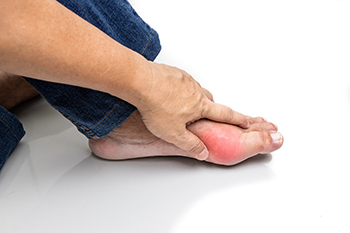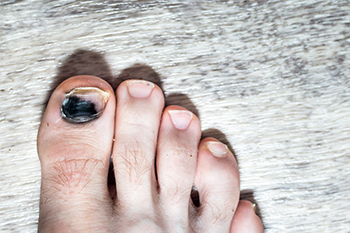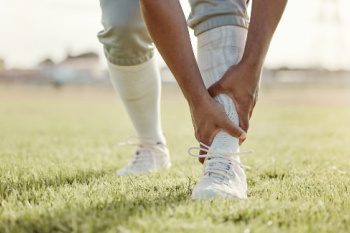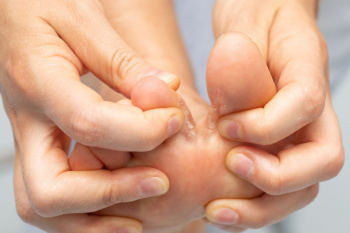Gout is a type of arthritis that can affect the foot. Gout is caused by a buildup of uric acid in the bloodstream. When uric acid levels become excessive, this substance can create crystals in the joints, causing severe pain, intense swelling, redness, and warmth. Typically this occurs in the big toe joint.
You may be at an increased risk of developing gout if you are a middle-aged man or postmenopausal woman, have family members who have had gout, drink alcohol, take certain medications, or have a medical condition like high blood pressure, kidney disease, thyroid disease, diabetes, or sleep apnea. Gout may also be more likely to develop if you consume a diet high in sugars or purines, a substance that turns into uric acid when it breaks down. Foods high in purines include organ meats, red meat, oily fish, certain vegetables, beans, and mushrooms.
Gout that is left untreated can become chronic and lead to arthritis. Gout can be treated by a chiropodist. Treatment options may include taking medications to relieve pain and prevent future gout attacks, modifying your diet, and reducing alcohol intake. For more information about gout, please consult with a chiropodist.

Tophaceous gout is a severe form of gout that occurs when uric acid crystals accumulate in the joints and soft tissues, forming hardened lumps called tophi. These lumps can cause noticeable swelling and excruciating pain, which often leads to reduced mobility and increased joint stiffness. Tophaceous gout typically attacks the big toe and develops in people who have had untreated or poorly managed gout for years. Symptoms of gout include sudden intense pain, redness, and warmth surrounding the affected joint. Over time, repeated flares can lead to the formation of tophi, which may cause permanent joint damage if left untreated. A chiropodist can help manage the foot-related symptoms of gout by offering treatment options, advice on lifestyle changes, and suggestions for footwear to minimize discomfort. Managing uric acid levels and receiving regular care can prevent gout from progressing to more serious stages. If you have toe pain related to gout, it is suggested that you schedule an appointment with a chiropodist for advice on relief solutions.
Gout is a painful form of arthritis that can affect anyone. Please consult with one of the specialists from Thornhill Foot Clinic. Our chiropodists will assess your condition and provide you with quality foot and ankle treatment.
What Is Gout?
Gout is characterized by sudden, severe attacks of pain, redness, and tenderness in the joints. This type of arthritis is caused by a buildup of uric acid in the bloodstream. When uric acid crystallizes in a joint, often the joint of the big toe, it can bring about a gout attack.
Symptoms
Symptoms of gout include:
- Sudden and severe pain
- Swelling
- Redness
- Warmth
- Joint stiffness
- Joint deformity
Diagnosis
A chiropodist will ask questions about your personal and family medical history, followed by an examination of the affected joint. Laboratory tests and x-rays are sometimes ordered to determine if the inflammation is caused by something other than gout. A sample of fluid taken from your joint can show whether it contains uric acid.
Treatment
Prescription medications or injections are used to treat the pain, swelling, and inflammation. Patients with chronic gout can also use behavioral modifications such as diet, exercise, and decreased intake of alcohol to help minimize the frequency of gout attacks. Foods and beverages that are high in purines should be avoided since purines are converted in the body to uric acid. If left untreated, this painful condition can leave your joint permanently damaged and swollen.
If you have any questions, please feel free to contact our office located in . We offer the newest diagnostic and treatment technologies for all your foot care needs.
The toes are hard at work every time you stand, walk, run, hop, skip, or jump. They help to push the foot off the ground and to keep you balanced. When a toe is in pain it can negatively impact your normal daily activities. Among the numerous causes for toe pain, the chief one is trauma, such as stubbing a toe or dropping something heavy on it. This often causes severe bruising and affects your ability to bear weight. Other common causes of toe pain are bunions, hammertoes, nerve damage, and toenail problems. In addition, toe pain can be caused by gout (a type of arthritis), rheumatoid arthritis, sprains, or warts. Further causes include toenail infections, ingrown toenails, and athlete’s foot infections. Treatment by a chiropodist varies according to the underlying cause of the pain. In case of a broken or severely bruised toe, the remedy is usually to brace or splint the toe. Certain medications can be prescribed to relieve pain and injections may be administered. X-rays and imaging tests may be performed to determine the cause and severity of the toe pain. Custom orthotics may also be prescribed and fitted to counteract toe deformities or other problems. If your toe pain continues or worsens, it is suggested that you visit a chiropodist for an exam, diagnosis, and appropriate treatment options.

Running is a fantastic exercise, but it can sometimes lead to toenail injuries or loss, particularly among those who run frequently or wear ill-fitting shoes. Repeated pressure or trauma, often from shoes that are too tight or a long downhill run, can cause blood to pool under the nail, turning it black. In severe cases, a black toenail may become painful and detached from the nail bed. Other causes of black toenails include fungal infections, which thrive in warm, moist environments like sweaty running shoes, or underlying health conditions such as diabetes or heart disease. While mild cases may resolve on their own, a chiropodist can evaluate the cause and offer treatment options. These might include draining built-up blood, addressing fungal infections, or recommending better-fitting footwear to prevent future issues. If you have a black toenail related to running, it is suggested that you schedule an appointment with a chiropodist.
Toe pain is common and can have a variety of causes. Causes can range from a broken toe to an ingrown toenail. Many types of toe pain can be corrected, but any toe pain that inhibits your activities for an extended period should be discussed with a chiropodist. If you suffer from toe pain, please consult with one of the specialists from Thornhill Foot Clinic. Our chiropodists can help you maintain the health of your feet.
Common Causes of Toe Pain
- Trauma or fracture
- Cuts, sores, or bruises
- Rheumatoid arthritis
- Gout
- Turf Toe
- Morton’s neuroma
- Blisters
- Corns
- Bunions
- Hammertoes
- Ingrown toenails
- Plantar warts
- Athlete’s Foot
Symptoms of Toe Pain
- Toe deformity
- Burning
- Numbness
- Toenail deformity
- Wart or ulcer
- Swelling
- Redness
When to See a Chiropodist
- Bleeding or severe swelling
- Trauma, such as a broken bone
- Discoloration or extreme swelling
- Inability to bear weight
- Persistent pain
- Wounds that won’t heal
Diagnosis of Toe Pain
A chiropodist can conduct a thorough examination of the painful toe or toes in order to determine the best course of treatment. The exam may include assessing the tenderness of the area, taking an X-ray or other diagnostic test, or assessing your gait and range of motion. A discussion of what led to the advanced pain issue may follow. Included will likely be a health history, as well as a list of medications you are taking and other previous injuries you may have sustained.
Treatment for Toe Pain
With such a wide range of possible causes for toe pain, treatment can be varied in scope and length. Sometimes, the chiropodist will recommend lifestyle and activity changes. In cases of trauma or other injuries, X-rays or imaging tests will likely be used to determine the severity of the problem, particularly if any bones have been broken. Treatment may also include injections of pain-relief medication or anti-inflammatory drugs. Certain injuries will require the splinting, bracing, or wrapping of injured toes. Orthotics or special shoes may be prescribed in cases of bone deformities and gait issues. Removal of warts, calluses, and corns may be needed. In other cases, such as with patients who have diabetes or rheumatoid arthritis, ongoing treatment may be required to avoid more serious problems.
If you have any questions, please feel free to contact our office located in . We offer the newest diagnostic and treatment technologies for all your foot care needs.
Participating in sports is great for maintaining your health and fitness, but can sometimes result in injuries to your feet or ankles. Common sports-related foot and ankle injuries include Achilles tendonitis, ankle sprains, stress fractures, turf toe, and plantar fasciitis.
Achilles tendonitis is a common injury in which the Achilles tendon located at the back of your ankle becomes inflamed due to overuse or biomechanical issues with the feet. Symptoms of Achilles tendonitis include pain in the lower calf, swelling, stiffness, redness, warmth, and reduced strength and range of motion.
Ankle sprains occur when the ligaments in the ankle are overstretched or torn. Depending on the severity of the injury, you may experience symptoms such as localized pain, swelling, and bruising at the site of the sprain, a limited ability to move the affected ankle, and difficulty walking.
Stress fractures are fine cracks that occur in the bones when they can’t bear the load placed on them. These fractures often occur in the foot bones and get worse over time if they are not promptly diagnosed and treated. Symptoms of stress fractures in the feet include tenderness, deep and dull or sharp and localized pain, weakness, swelling, and bruising.
Turf toe is a sprain of the largest joint in the big toe. It can cause symptoms such as pain, swelling, or tenderness that vary in intensity depending on the severity of the injury.
Plantar fasciitis is an inflammation of the ligament that runs along the bottom of the foot. This condition usually causes stabbing heel pains, arch pain, and pain when taking your first steps after a long period of rest.
If you have injured your feet or ankles while playing sports, it is recommended that you see a chiropodist who can diagnose and treat your condition and get you back on your feet.

Rehabilitating foot injuries, such as lateral ankle sprains, in athletes requires a strategic approach to restore strength, stability, and proper gait mechanics. Once the acute phase subsides, targeted exercises are essential for recovery. Strengthening exercises, such as resistance band workouts for the ankle and foot, help rebuild muscle support around the injured area. Balance and proprioception exercises, like standing on one leg or using a balance board, are important for restoring stability and preventing future injuries. Gait mechanics must also be addressed during rehabilitation. Athletes should work on correcting any abnormal walking or running patterns that may have developed due to the injury. This can involve gait analysis and guided retraining to ensure proper foot alignment and motion. Gradual return to sport-specific activities under professional supervision is key to ensuring a safe and effective recovery, reducing the risk of reinjury. If you are an athlete who has sustained a foot or ankle injury, it is suggested that you see a chiropodist for a proper diagnosis and care.
Injuries to the foot and ankle are very common among athletes. If you have experienced an injury, please consult with one of the specialists from Thornhill Foot Clinic. Our chiropodists will assess your condition and provide you with quality foot and ankle treatment.
Common Injuries Among Athletes:
- Achilles tendon injuries
- Ankle strains or sprains
- Plantar fasciitis
- Fractures
- Turf toe
- Joint dislocations
- Sever’s disease
- Morton’s neuroma
Symptoms
Symptoms will depend on the cause and severity of the injury. Common symptoms for a foot or ankle injury include pain, swelling, tenderness, bruising, a reduced range of motion, and difficulty bearing weight or walking on the affected foot or ankle.
Diagnosis
Sports injuries are typically diagnosed after carefully examining the affected foot or ankle. This includes moving the injured area to test its range of motion. Medical history will need to be provided, as well as detailed information about how the injury occurred. Imaging studies, such as X-rays or MRIs, may be used to confirm or rule out certain diagnoses.
Treatment
Just like symptoms, treatment will depend on the type of injury and its severity. Initial treatment for many sports injuries is aimed at controlling inflammation and promoting the healing response. The acronym R.I.C.E is a helpful guide to implement for most acute injuries. This method involves resting, icing, compressing, and elevating the affected foot or ankle. In addition, anti-inflammatory medications may be administered and orthotic devices may be prescribed. For more severe injuries, surgery may be required. Lastly, rehabilitation or physical therapy may be needed to gain full functionality in the afflicted area.
If you have any questions, please feel free to contact our office located in . We offer the newest diagnostic and treatment technologies for all your foot care needs.

Athlete’s foot, medically known as tinea pedis, is a fungal infection affecting the skin on the feet. The condition typically causes itching, redness, and peeling between the toes and the soles of the feet. There are several types of athlete’s foot, including interdigital, which affects the spaces between the toes. Another type of athlete’s foot, called moccasin, causes thickening and scaling on the soles. Vesicular athlete’s foot results in fluid-filled blisters. Risk factors for developing all types of athlete’s foot include wearing damp or tight-fitting shoes, walking barefoot in communal areas like pools or gyms, and having a weakened immune system. Fungal infections thrive in warm, moist environments, making sweaty feet particularly susceptible. If you have developed athlete’s foot, it is suggested that you consult a chiropodist for treatment.
Athlete’s foot can be uncomfortable and unsightly. To learn more about preventing and treating this condition, please consult with one of the specialists from Thornhill Foot Clinic. Our chiropodists will assess your condition and provide you with quality foot and ankle treatment.
What Is Athlete’s Foot?
Athlete’s foot refers to an infection of the skin on the feet that is caused by a fungus. This fungus is contagious and thrives in warm and moist environments. It is often spread in common areas such as public pools, locker rooms, and showers. It can also spread when sharing personal items, like shoes or towels, with an infected person.
Symptoms
The symptoms of athlete’s foot may include:
- Itching, stinging, or burning of the skin on the feet
- Cracking or peeling skin, especially between the toes and on the soles of the feet
- Scaly, red rash on the foot
- Blisters
- Foul odor
Treatment
Treatment for athlete’s foot typically involves using over-the-counter topical antifungal medications on the feet. When over-the-counter options are ineffective, you may need to take prescription oral medications or topical antifungal drugs, or a combination of both.
Prevention
Preventing athlete’s foot places an emphasis on good foot hygiene practices.
You can prevent athlete’s foot by:
- Washing and drying your feet thoroughly every day
- Wearing shoes when walking in public areas
- Not sharing personal items, like shoes or socks, with others
- Wearing shoes and socks made out of breathable materials
If you have any questions, please feel free to contact our office located in . We offer the newest diagnostic and treatment technologies for all your foot care needs.
Athlete’s foot, also known as tinea pedis, is a fungal infection of the skin of the feet. The fungus that causes athlete’s foot lives and thrives in warm, moist environments such as public swimming pools, locker rooms, and showers. This fungus can infect the feet through a cut or crack in the skin. Athlete’s foot is also highly contagious, and the fungus can spread from person to person through sharing personal items such as shoes, socks, or towels.
The symptoms of athlete’s foot include itching, stinging, or burning between your toes or on the soles of your feet, itchy foot blisters, and dry, cracked, or peeling skin on the feet. The infection can also spread to your toenails, leading to discoloration, thickening, and crumbling.
Through a physical examination, athlete’s foot can be diagnosed by your chiropodist based on its symptoms. Sometimes, a skin test may be ordered to confirm the diagnosis. Athlete’s foot can be treated with both oral and topical over-the-counter or prescription medications. You can prevent a fungal infection by maintaining good foot hygiene, wearing shoes when walking in public areas, avoiding sharing personal items with others, and keeping your feet clean and dry.


